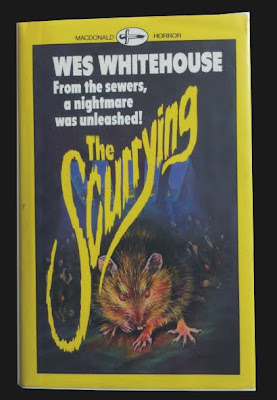Man-eating plants have always fascinated me. I believe it goes back to when, as a child, I saw what memory suggests was a clip of an Eddie Romero "Blood Island" film on a cinema review programme. It showed men battling with the tentacle-like branches of a living tree. I thought it was real.
John Wyndham’s
Day of the Triffids is probably the most famous novel that deals with the menace of ambulating plants. Here are a few examples of others stories that appeared in the 70s and 80s.
Hurriedly reprinted tales to cash in on the popularity of Peter Tompkin’s and Christopher Bird’s
The Secret Life of Plants (1974) that was popular at the time is
Roots of Evil: Beyond the Secret Life of Plants (Corgi 1976). An anthology of a dozen vintage short stories date ranging from 1925 to 1965. The highlight is Clark Ashton Smith’s truly horrible
Seeds from the Sepulchre in which an explorer in the Venezuelan jungle becomes the living host of a terrible plant form that grows from within slowly pushing thick tendrils through the sutures of his skull and other bodily orifices. The remaining contents are:
The Flowering of the Strange Orchid – H. G. Wells;
Rappaccini’s Daughter – Nathaniel Hawthorne;
Dorner Cordaianthus – Hester Holland;
Come into my Parlor – Manly Wade Wellman;
The Tree’s Wife – Mary Elizabeth Counselman;
The Ivy War – David H. Keller;
Green Thoughts – John Collier;
Dr. Adam’s Garden of Evil – Fritz Leiber;
Daisies – Fredric Brown;
The Gardener – Margaret St. Clair;
Green Thumb – Clifford Simak.
Robert Charles’
Flowers of Evil was published by Futura in 1981. “The plant was a haunting nightmare. Heavy with the blood of the mangled creatures whose decaying flesh decorated its foliage. Brooding, it awaited its next victim; it wrist-thick tentacles weaving gently.” An undisclosed nuclear accident in Russia has contaminated a vast area of land. Over the years a plant species has mutated and turned carnivorous. Due to the lack of nourishment on the devastated land it has remained a small flowering shrub. A researcher’s assistant takes a sample from the affected zone and the plant thrives and multiplies once it reaches civilisation. Before she is aware of the danger she has given her brother a potted flower to decorate the cabin of his deep sea trawler. The main part of the plot takes place on an island where an ornithologist and his family are isolated. Despite the awful cover image (what are those eyes about?) the book is a tremendous read.
Again in 1981 another mutant plant novel appeared. Lewis Mallory’s
The Nursery (Hamlyn) in which a professor produces blood-drinking orchids. Hamlyn labelled the book as a ‘Fiction Nasty’.
"The door opened before him and he entered the laboratory. At the centre of the room was a sight more horrific than he had ever dreamed of. Professor Durant sat upon his chair, his flesh pierced by a network of needles. Tendrils of plants were twined around his body. His face was white and drained of blood. No sound came from him. It was as if they had squeezed the breath out of him. The only noise which remained was the sucking sound of the plants and the buzz of their pleasure."
1988 saw the publication of Edmund Plante’s
Garden of Evil (BMI) in which a child innocently plants seeds found in an old box that belonged to a long-dead alchemist. The consequences, of course, are not good.
"...Molly rushed toward the nearst bathroom, found a gilded hand mirror, and raced back into the kitchen with it.
"Leave me... alone," her mother moaned when she shook her shoulder. The pale blue flower that hid her face seemed to have grown larger since Molly had left the room.
"Look, Mom, look!" She shook her mother harder, holding the mirror before her.
At length Lara pulled her face away and peered through small, glazed eyes into the mirror. A thin smear of blood ran from below one nostril down her chin, and the sore from which it bled was the size of a dime and shredded, as though it had been chewed. Now that the flower was not absorbing the wound anymore, the blood bubbled forth and trickled bright red, passing her chin and streaking her neck.
"It's eating your face, Mom."
There may be more titles from the 70s and 80s that I am unaware of.









